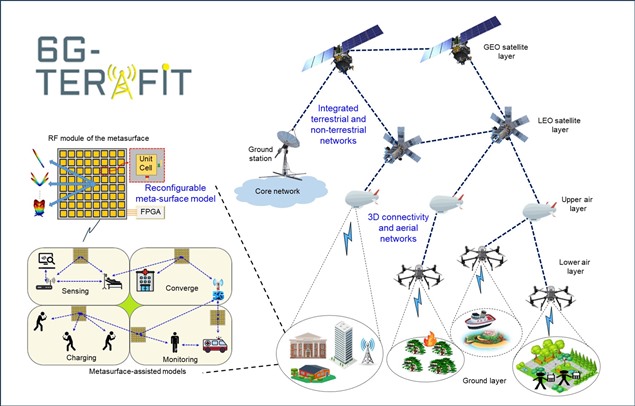By University of Bradford et al.
This work is supported by the UK Engineering and Physical Sciences Research Council (EPSRC) under grant EP/Y035135/1, and HORIZON-MSCA-2022-SE-01-01-ID: 101131501, MARIE SKŁODOWSKA-CURIE ACTIONS Staff Exchanges (SE)
University of Bradford, United Kingdom: Raed A Abd-Alhameed, Viktor Doychinov, Vuong Mai, Ifiok Otung
The Instituto de Telecomunicações, Campus Universitário de Santiago 3810-193 Aveiro: Issa T. E. Elfergani, Jonathan Rodriguez
Paderborn University, Germen: Jens Förstner, Christian Hedayat
SARAS TECHNOLOGY LIMITED, United Kingdom: Ashwain Rayit
THINGENIOUS LIMITED, Greece: Aristidis Konstantas, Dimitris Uzunidis
Summary and objectives of the project:
Numerous new applications, such as big data analysis, artificial intelligence and three-dimensional (3D) media, Internet of things, and others, have been making their way into our society with considerable volumes of data flow. This is due to the rapid growth of electronic devices and computing technology. In spite of the fact that mobile networks are already indispensable to our society for providing "anywhere anytime connection," one of the most important characteristics of future mobile networks (also known as B5G: Beyond 5G) is the extremely large amount of data that will be transmitted. This necessitates a very high throughput per device (multiple Gbps, up to Tera bps: Tbps) and multiple Tbps per area efficiency (Tbps/km2). Although certain disruptive 5G technologies may be able to deliver service at a few gigabits per second (Gbps), it is still not capable of achieving speeds of hundreds of gigabits per second (Gbps) or terabits per second (Tbps).
 European 6G TERAFIT Project Configuration
European 6G TERAFIT Project Configuration
In the not-too-distant future, it is anticipated that the peak rate of mobile communication networks could approach hundreds of gigabits per second (Gbps) or even terabits per second (Tbps). This would necessitate either extremely high spectrum efficiency (for example, significantly higher than 10 bits per second per Hz) in millimetre wave bands or extremely huge bandwidth (for example, more than 20 GHz). In contrast to the former, which is extremely difficult to do, the latter may be accomplished in THz ranges (approximately 100 GHz to 10 THz). Therefore, the purpose of this collaborative 6G-TERAFIT is to create a knowledge transfer between the researchers and the engineers who will contribute to the design and implementation of future B5G ultra-fast networks and to create the pedestal for them to become potential leaders in the scientific, technological, and industrial fields that will result from the development of future mobile networks. The design of ubiquitous access with very high rates in mobile and heterogeneous network (HetNet) environments is the key to the development of future mobile networks. Creating an "excellent" educational training platform that is multi-disciplinary and inter-sectoral in character is the goal of this project, which is devoted to carrying out its mission.
The ultimate primary goal of 6G-TERAFIT is to facilitate a knowledge transfer between the researchers and the engineers who will contribute to the design and implementation of future B5G ultra-fast networks. In the field of wireless communications, particularly in the areas of THz, propagation modelling, and commercial software production, the 6G-TERAFIT consortium has earned an excellent reputation for its work. Each of the partners in the consortium is a well-known expert in their respective fields, and the group as a whole has earned this reputation.
By developing and designing network systems that enable spectrum and advanced technologies for seamless wireless access in the TeraHertz frequency band (roughly 0.1THz to 10THz), the 6G-TERAFIT project aims to address these issues. It is anticipated that this band will provide ultra-fast rates (Tbps) and will be an integral part of the future multi-RAT ecosystem. Additionally, it has the potential to serve as the foundation for B5G technologies. Furthermore, we will examine the information-theoretic constraints and error control mechanism of THz channels and networks, as well as model the broad diversity of THz channels for both mobile (RAN) and fixed (backhauls) networks. In addition, we will have the opportunity to model the THz channels. Additionally, air interfaces and multiple-access protocols will be examined and created in this development process.
For the purpose of enhancing seamless access, the integration of radio access networks (RAN) and fronthaul/backhaul optimisation will be developed. An environment that includes a hardware-in-the-loop simulator and a system-level simulator will be developed in order to guarantee the effectiveness of the technologies that are developed. It is the hope of 6G-TERAFIT to bridge the gap between the current networking technologies and the anticipated needs of networking. This will be accomplished by delivering ultra-higher rates, the capability to support massive users, sufficiently-long transmission distance in various communication scenarios, ultra-lower cost per bit, ultra-enhanced energy efficiency, and finally, adaptability to new services and devices.
The 6G-TERAFIT project will investigate information-theoretic performance limits and concrete design principles for radio-interface (waveform and modulation) based on the channel characteristics of THz bands, which include high directionality, high path loss, and hardware impairments, among other constraints. Additionally, the project will take into consideration a number of other constraints, such as distance, hardware, energy efficiency, and size.
The 6G-TERAFIT project will research THz MAC layer protocols in addition to physical layer and signal processing approaches in order to give seamless access to Tbps in heterogeneous and mobile environments. As a result of this, 6G-TERAFIT would also provide architectural enablers for merging the THz-wave technology with other technologies that go beyond 5G and legacy technologies (non-standalone) in order to attain ubiquitous access. One example of this would be through collaboration in lower frequency bands. In addition to testing, validating, and calibrating proposed algorithms and protocols on software tools and hardware platforms, the 6G-TERAFIT will also provide early-stage researchers with the practical expertise necessary to get their research closer to the point where it can be commercialised.